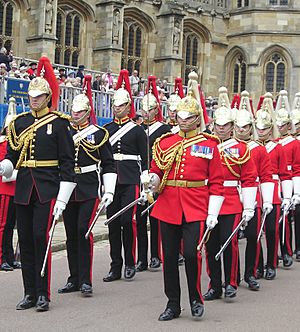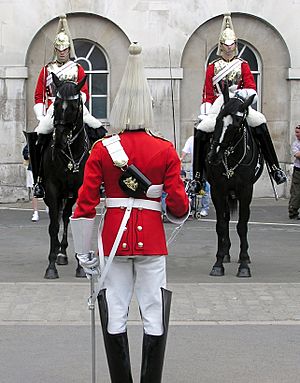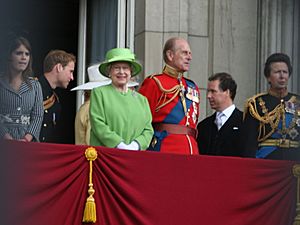Household Cavalry facts for kids
The British Household Cavalry is a special part of the British Army. It's made up of two groups of soldiers called regiments. Long ago, cavalry soldiers always rode horses. Today, most cavalry regiments use tanks and other armoured vehicles.
What makes the British Household Cavalry special is that half of its soldiers still ride horses for important events! The other half uses modern armoured vehicles. Both groups are made up of soldiers from two famous regiments: The Life Guards and The Blues and Royals. These regiments are part of the "Household Division," which has the special job of guarding the King or Queen and the Royal Family in Britain.
Many other countries also have special army groups that guard their leaders and perform ceremonial duties. You can find similar groups in places like Australia, Canada, and Denmark. But when people talk about "the Household Cavalry" in English, they usually mean the British Household Cavalry.
Contents
Meet The Life Guards and The Blues and Royals

The British Household Cavalry is made of two historic regiments: The Life Guards and The Blues and Royals. These are the oldest regular regiments in the British Army, with traditions going all the way back to 1660.
These soldiers are often called the Horse Guards for short. Their barracks, or living quarters, are in Hyde Park Barracks in Knightsbridge, London. Their main job is to form The King's Life Guard every day at a building in London called "Horse Guards." This building used to be the main office for the British Army.
You can always see mounted guards outside the "Horse Guards" building. In front of it is the famous Horse Guards Parade, where big events like The King's Birthday Parade happen. Every day, a ceremony called the Changing of The King's Life Guard takes place there. This is different from the Changing of the Guard you might see at Buckingham Palace.
The King or Queen is the Colonel-in-Chief of both Household Cavalry Regiments. This means they are the special head of these regiments. The motto for both regiments is Honi Soit Qui Mal Y Pense, which means "Shame on him who thinks evil of it."
As military regiments, The Life Guards and The Blues and Royals have served in many places around the world. They have been part of important events and conflicts from 1660 to today. This includes serving in places like France, Iraq, North Africa, the Falkland Islands, Bosnia, Kosovo, and Afghanistan.
What Do Their Uniforms Look Like?
The special ceremonial uniform of the Household Cavalry is very striking. It has some unique features you don't often see on other soldiers.
They wear a shiny silver helmet with brass and silver parts. A long "plume" of horse hair hangs from the top. When they are on mounted guard duty, they also wear a "cuirasse." This is a metal chest armour that protects them.
You can tell the two regiments apart by the colour of their jacket, which is called a "tunic," and by the plumes on their helmets.
- The Life Guards wear red tunics with white plumes.
- The Blues and Royals wear blue tunics and have red plumes on their helmets.
When on guard, the soldiers carry swords. When they are riding horses, they wear white riding trousers called buckskins. They also wear tall, black leather boots that are reinforced against sword blows. These are called jack boots.
The "farrier" is a soldier who helps the army vet take care of the horses. When the farrier is on parade, they carry a traditional axe. Long ago, a farrier's job in battle included putting down badly injured horses. They also had to cut off a hoof to prove the horse had died so a new one could be bought.
Most of the horses are black Irish draught horses. However, the trumpeters' horses are grey. The drumhorses are large, strong horses, usually black and white (piebald), brown and white (skewbald), or roan. Each drumhorse carries two solid silver kettle drums during parades.
The trumpeter's job is to send messages using a trumpet. You can spot them because they don't wear a cuirasse and ride a grey (white) horse. For big "State occasions" when the King or another Royal Family member is present, the Household Cavalry bands wear special gold coats. These coats were designed around the time of King Charles II and are made of gold braid and dark blue velvet. Each regiment has its own Quick March and Slow March tunes. They both use a Scottish tune called The Keel Row for a ceremonial "trot past."
The Household Cavalry's Modern Role
The Household Cavalry Regiment is an armoured reconnaissance regiment based in Windsor. "Reconnaissance" means they are trained to gather information about the enemy and the battlefield.
Most Household Cavalry soldiers start their careers with mounted duty, performing ceremonies. After about two years, they usually move to the reconnaissance regiment. Here, they train with Scimitar light tanks, learning how to drive them, use their guns, and send signals.
This regiment has been sent on more missions than almost any other in the British Army. They have served in places like Bosnia, Kosovo, Iraq, and Afghanistan. Soldiers from the Household Cavalry have received many bravery medals for their actions in these operations. These include the George Cross (GC), Conspicuous Gallantry Cross (CGC), and Military Cross (MC).
Famous Members of the Household Cavalry
- Her Royal Highness Princess Anne, The Princess Royal, is the Colonel of The Blues and Royals.
- Prince William and his brother Prince Harry of Wales have both served as "cornets" (a junior officer rank) in The Blues and Royals.
Gallery
The British Household Cavalry
-
The Mounted Bands of the Household Cavalry at the "Trooping of the Colour" salute H.M. Queen Elizabeth II as they ride off parade.
"Horse Guards" from other countries
Other pages
Images for kids
See also
 In Spanish: Household Cavalry para niños
In Spanish: Household Cavalry para niños















